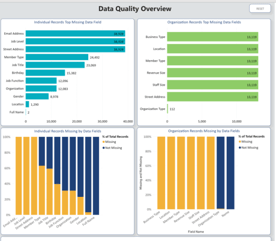The concept of “dirty data” and how to approach it can be daunting. Simply put, dirty data is data that is inaccurate, incomplete, inconsistent, duplicative, or outdated. At Association Analytics, we sometimes hear concerns about data quality in the context of associations starting their journey into analytics. To help alleviate your fear of dirty data, we have some tips on how to tackle cleaning it up and getting your database in great shape. Spoiler alert – we’ve never encountered an association database that wasn’t in good enough shape to start performing analytics. And a surprise for some – associations can use analytics to help identify where to focus their data cleansing initiatives.
Identify your unique data challenges.
- Quality: How up-to-date is your data? How accurate is it? What sources are you using?
- Integrity: Duplicate records? Do you have multiple records for one member or lead? This might happen when a member uses different email addresses to register for events and make purchases.

- Completeness: What is the completeness of your data fields?How important is it to you to have each field complete? Example: email should be close to 100%, other fields like interests aren’t as important to capture initially.
- Management: Is someone in your organization assigned to manage data hygiene? Have you allocated time for routine maintenance?
Tackle the clean up one step at a time.
It may seem like an overwhelming task, but if you break the project into small pieces, starting to clean your data will be much easier. You don’t need to fix all the fields at once. We suggest you prioritize data quality tasks. Start the process by looking at your data from these perspectives:
- Strategic Alignment: Prioritize the data points that are most essential to your strategic priorities.
What is important to your association and what are your unique KPIs? Focus on critical data points. You definitely need billing data, but knowing your member’s fax number is likely less important. - Revenue Potential: Identify the fields that are important to what drives revenue, things like renewals, event registration, and enrollment in learning programs.
- Low Hanging Fruit: For a quick win, find a field that you already have a lot of information for and use that as a starting point for your clean-up process. You should be able to update any empty or incorrect fields for this data set pretty quickly and move on to the next one.
Put a plan in place for data quality.
You have identified your data issues and prioritized what data fields to address first. You also need to manage your data properly. After all, your data is an important asset that needs to be maintained. It is good business practice to spend time managing it. By doing so, you will see a return on investment. As you plan for ongoing data quality management, take these tasks into consideration:
- Allocate Resources: Investigate your situation. Don’t assume that this is a huge mess until you see the actual discrepancies. Once you have this information, assign dedicated resources and time to manage data.
- Assign Data Owners: Every data set and source must have someone responsible for maintaining quality. These owners should budget time to manage your data and set completeness thresholds. Time spent on data management may vary based on your association’s activities. After a trade show, you may need to spend more time on data hygiene than other times.
- Measure Progress: Stay on top of your data. Set a baseline and keep track of the progress you are making. Keep monitoring the growth with metrics (for example, decreased number of duplicates, increase in completion rate of certain fields.)
- Continuous Improvement: This is a process that will take some time (and patience 🙂 ). Be creative on how you capture data. Use tactics that are fun or provide a value for people to share their information with you. Use visualizations to see gaps that need attention. For example, if you are hosting an in-person seminar ask the attendees to text questions to you (and give them an incentive to do it). It’s an easy way to collect phone numbers for your database.
Just get started.
Don’t put off this process just because you have little data or old information. Use what you have and build on it. Here are some easy steps to get started:
Start Collecting Data:
- Be consistent and deliberate with your collection processes.
- Keep in mind the delicate balance of your need for data without asking people for too much information.
- Be creative. Instead of collecting in a traditional way, find a way to collect data in a way that is exciting or engaging.
- Make it easy for people to provide information to you.
Establish Data Governance Policies:
- Put a data source inventory in place if you don’t have one. This is a list of all your systems that contain data about your members and business.
- Create a glossary to track and communicate official terms and definitions. This will help reduce confusion and create a common business language.
- Establish a data dictionary to track and communicate technical information related to the data items which are elements of the data set.
- Build a data catalog that provides a consolidated view of your data sets such as member joins, registrations and sales.
Get a trusted partner to help.
Most associations can tackle data cleansing on their own by following the steps outlined above. However, if you need or want help with various aspects of cleaning, Association Analytics has services to help. In addition to assisting associations with data cleansing, we also help you visualize your data quality in our analytics platform, Acumen, including individual record, location and demographic completeness, organization record completeness and individual and organization duplicate records.
Learn more about data hygiene and hear use case examples in our recent webinar.
Schedule a personalized demo to learn more about how Association Analytics can get you started on your analytics journey.



